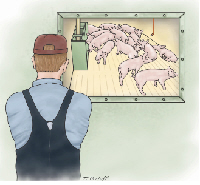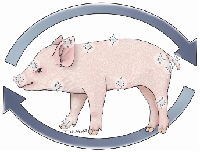



Identification of the Sick or Compromised Pig
Madonna Benjamin (Extension Swine Veterinarian) and Scott Kramer (student at the College of Veterinary Medicine at Michigan State University) explain the B.E.S.T. system, developed to help the stockperson remember to observe all aspects of the pig in 'MSU Pork Quarterly'.Identification of compromised pigs requires an awareness of the entire population and necessitates timely decisions in respect to treatment, transportation and/or euthanasia.
Daily observations of pigs by walking the pens will contribute to early identification of pigs in good and poor health. Initially, try to assess a group of pigs from a distance before disturbing them. This allows you to make an assessment of their behaviour (Figure 1.).

We suggest scanning the pens for down or lame animals, increased activity near the water or feeders and listening for coughing or sneezing. Observe the ventilation for faulty or mismanaged air quality such as pigs piling due to cold air draughts.
Next, enter the room or area quietly and observe
the pigs individually and using a system we call B.E.S.T. System. This acronym stands for:
- Body
- Eyes/Ears/Nose
- Skin/Hair-coat
- Temperament.
In a consistent and systematic routine, observe each pig, in a clockwise direction, from snout to tail (over the back) and then tail to snout (across and under the belly). (Figure 2.)
The Body should be sound and well muscled. The spine, hips and ribs should not be visible in nursery or finishing pigs. Prominent spines are an indication of malnutrition (inadequate food access or intake) or malabsorption (inadequate absorption of feed consumed). The tail is without lesions and/or bites and the area around the anus and vulva (females) should be clear without evidence of diarrhea. The feet and legs appear similar, without swelling or lesions or cracks on the toes, and the pig should be able to walk without signs of lameness. The belly of the healthy pig appears full. Clinical signs of panting, thumping/laboured breathing, coughing, wheezing or sneezing are not indications of a normal and healthy pig. Shaking, prostrate and paddling or lack of balance are also abnormal behaviour.

Eyes, ears and nose should be pink and free from lesions or secretions. Dull, sunken or irritated eyes may indicate a sick pig. Cloudy or dark discharge around the eye is commonly seen in cases of respiratory disease. The pig’s normal ears are generally clean and free from accumulations, swelling, parasites or injury. The nose should be cool and moist, devoid of lesions and without deviation to the right or left.
Skin and Hair should be smooth, clean, and uniform in density. Lumps, bumps, sores, scaly or loss of skin or hair, or crustiness may be from parasites, infection, fighting or nutritional deficiency. Ulceration on the skin may indicate belly nosing and scales or crusting might indicate mange. Geometric or exudative lesions are generally caused by bacteria.
Temperament: Pigs by nature are naturally inquisitive and are should be responsive to their environment with natural curiosity1. When approached, pigs might move away initially but will return and investigate, snuffling and biting at boots and clothing. Sick pigs may be observed purposefully avoiding you and away from the group, with their head and ears down.
In summary, responsible pig care requires that the compromised animal(s) are identified and that the stockperson act quickly to treat, cull or euthanise the compromised pig.
The first step in identification of a sick pig is in taking the time to observe all the pigs in a pen or area as a population followed by individual pig observations systematically in a clockwise direction. Using the B.E.S.T. system, the stockperson will remember to observe all aspects of the pig.
References
1. Animals Make Us Human: Creating the Best Life for Animals by Dr. Temple Grandin and Catherine Johnson.
June 2014








